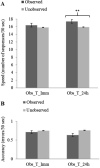Sequence-specific delayed gains in motor fluency evolve after movement observation training in the absence of early sleep
- PMID: 38369529
- PMCID: PMC10874966
- DOI: 10.1038/s41598-024-53004-4
Sequence-specific delayed gains in motor fluency evolve after movement observation training in the absence of early sleep
Abstract
Following physical practice, delayed, consolidation-phase, gains in the performance of the trained finger-to-thumb opposition sequence (FOS) can be expressed, in young adults, only after a sleep interval is afforded. These delayed gains are order-of-movements specific. However, in several perceptual learning tasks, time post-learning, rather than an interval of sleep, may suffice for the expression of delayed performance gains. Here we tested whether the affordance of a sleep interval is necessary for the expression of delayed performance gains after FOS training by repeated observation. Participants were trained by observing videos displaying a left hand repeatedly performing a 5-element FOS. To assess post-session observation-related learning and delayed gains participants were tested in performing the observed (trained) and an unobserved (new, the 5-elements mirror-reversed) FOS sequences. Repeated observation of a FOS conferred no advantage to its performance, compared to the unobserved FOS, immediately after practice. However, a clear advantage for the observed FOS emerged by 12 h post-training, irrespective of whether this interval included sleep or not; the largest gains appeared by 24 h post-training. These results indicate that time-dependent, offline consolidation processes take place after observation training even in the absence of sleep; akin to perceptual learning rather than physical FOS practice.
© 2024. The Author(s).
Conflict of interest statement
The authors declare no competing interests.
Figures



Similar articles
-
Sequence specific motor performance gains after memory consolidation in children and adolescents.PLoS One. 2012;7(1):e28673. doi: 10.1371/journal.pone.0028673. Epub 2012 Jan 19. PLoS One. 2012. PMID: 22276097 Free PMC article. Clinical Trial.
-
Procedural Memory Consolidation in Attention-Deficit/Hyperactivity Disorder Is Promoted by Scheduling of Practice to Evening Hours.Front Psychiatry. 2017 Aug 3;8:140. doi: 10.3389/fpsyt.2017.00140. eCollection 2017. Front Psychiatry. 2017. PMID: 28824471 Free PMC article.
-
Limits on movement integration in children: The concatenation of trained subsequences into composite sequences as a specific experience-triggered skill.Neurobiol Learn Mem. 2015 Sep;123:58-66. doi: 10.1016/j.nlm.2015.05.007. Epub 2015 May 21. Neurobiol Learn Mem. 2015. PMID: 26004677
-
Interference to consolidation phase gains in learning a novel movement sequence by handwriting: dependence on laterality and the level of experience with the written sequence.Exp Brain Res. 2007 Jun;180(2):237-46. doi: 10.1007/s00221-007-0851-1. Epub 2007 Feb 2. Exp Brain Res. 2007. PMID: 17273873
-
Motor memory consolidation processes in young female adults with ADHD may be less susceptible to interference.Neurosci Lett. 2017 Jan 10;637:91-95. doi: 10.1016/j.neulet.2016.11.044. Epub 2016 Nov 22. Neurosci Lett. 2017. PMID: 27888044
References
-
- Anderson JR. Acquisition of cognitive skill. Psychol. Rev. 1982;67:81–95.
-
- Logan GD. Toward an instance theory of automatization. Psychol. Rev. 1988;95:492. doi: 10.1037/0033-295X.95.4.492. - DOI
MeSH terms
LinkOut - more resources
Full Text Sources

